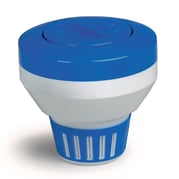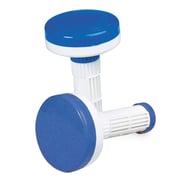If you’ve been with us for any issue on this series about the parts of a pool, you are no doubt familiar with what I am about to say regarding chemical feeders and generators. I say it to nearly every customer who comes to our Retail Center regarding everything from large equipment to different chemical lines we sell.
There is no one right piece of equipment or method of sanitization. It all depends on what works best for you and your pool.
Equal parts aggravating and liberating, this has made a huge difference for many of our shoppers and their approach to their pool care and maintenance. What works for me, my family, my lifestyle, how I intend to use my pool, and what chemistry trends I see in my pool.
Chemical feeders of all types serve one purpose—to sanitize your pool or spa. Almost all pool experts will tell you when you administer chemicals to your pool water, you ought to “brush it in.” This agitation of the water discourages any undissolved and undiluted chemical from settling on the floor or clinging to the walls of your pool, which will lessen the chances that the chemical will stain, strip, or damage your pool’s finish. Simplifying this task for you is an additional purpose of most chemical feeders, and each can save you time and effort to varying degrees.
The larger umbrellas that nearly all chemical feeders fall under are mechanized (partially or fully automatic), and non-mechanized.


Floaters (or floating tab dispensers) are non-mechanized, and slowly dispense the chlorine or bromine as the compressed tablets dissolve in the pool water that passes through the dispenser as it floats on the surface of the water. Nearly all compressed tablets come in one of two sizes, 1" and 3". Floaters therefore are designed for either size. Bromine floaters are popular for hot tubs, and some even have little characters that sit on top like rubber ducks and sharks. It can be a fun way to draw attention to the chemical feeder so that bathers remember to remove it from the pool before diving in.
It is important to note that if you have used a floating dispenser for one type of chemical, chlorine tablets, bromine tablets, etc., that you do not use the same dispenser for a different chemical. Residual chemicals can have negative and even dangerous reactions with introduced to one another. If you decide to switch from Trichlor to Calcium-Hypochlorite, or from any chlorine to a bromine tablet, you must invest in a new floating dispenser, or any other mechanized or non-mechanized chemical feeder for that matter.
In our next entry, we will further examine different types of mechanized chemical feeders, keeping in mind that floating dispensers are ideal for homeowners who use their pool or spa often, and have the availability to replenish their chemical tabs on an as needed basis.